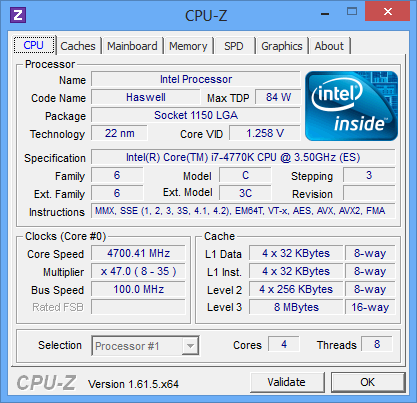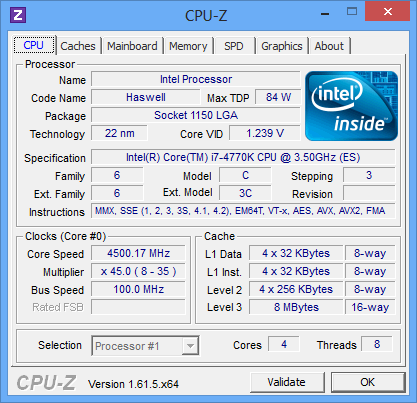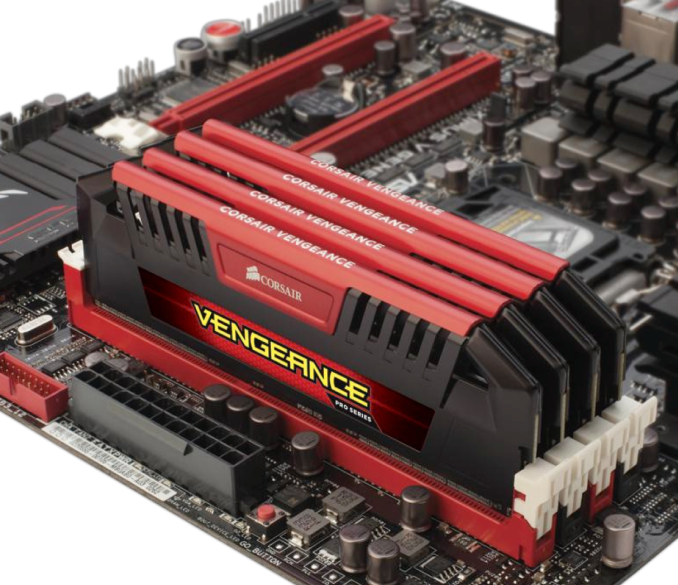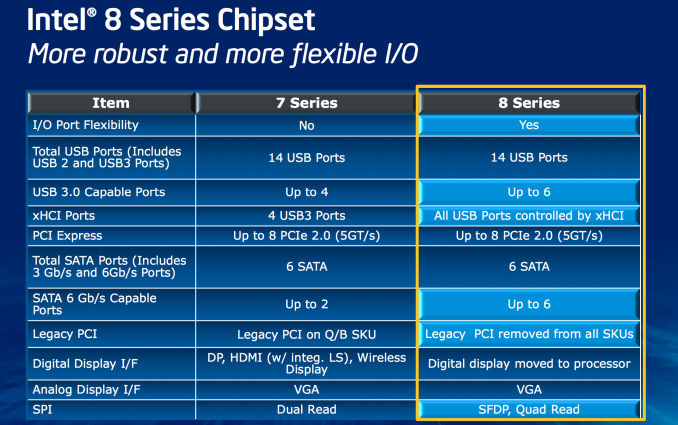The Haswell Review: Intel Core i7-4770K & i5-4670K Tested
by Anand Lal Shimpi on June 1, 2013 10:00 AM ESTMemory
Haswell got an updated memory controller that’s supposed to do a great job of running at very high frequencies. Corsair was kind enough to send over some of its Vengeance Pro memory with factory DDR3-2400 XMP profiles. I have to say, the experience was quite possibly the simplest memory overclocking I’ve ever encountered. Ivy Bridge was pretty decent at higher speeds, but Haswell is a different beast entirely.
Although I used DDR3-2400 for most of my testing, Corsair’s Vengeance Pro line is available in frequencies rated all the way up to 2933MHz.
Platform
Haswell features a new socket (LGA-1150). Fundamental changes to power delivery made it impossible to maintain backwards compatibility with existing LGA-1155 sockets. Alongside the new socket comes Intel’s new 8-series chipsets.
At a high level the 8-series chipsets bring support for up to six SATA 6Gbps and USB 3.0. It’s taken Intel far too long to move beyond two 6Gbps SATA ports, so this is a welcome change. With 8-series Intel also finally got rid of legacy PCI support.
Overclocking
Despite most of the voltage regulation being moved on-package, motherboards still expose all of the same voltage controls that you’re used to from previous platforms. Haswell’s FIVR does increase the thermal footprint of the chip itself, which is why TDPs went up from 77W to 84W at the high-end for LGA-1150 SKUs. Combine higher temperatures under the heatspreader with a more mobile focused chip design, and overclocking is going to depend on yield and luck of the draw more than it has in the past.
Haswell doesn’t change the overclocking limits put in place with Sandy Bridge. All CPUs are frequency locked, however K-series parts ship fully unlocked. A new addition is the ability to adjust BCLK to one of three pre-defined straps (100/125/167MHz). The BCLK adjustment gives you a little more flexibility when overclocking, but you still need a K-SKU to take advantage of the options.


In terms of overclocking success on standard air cooling you should expect anywhere from 4.3GHz - 4.7GHz at somewhere in the 1.2 - 1.35V range. At the higher end of that spectrum you need to be sure to invest in a good cooler as you’re more likely to bump into thermal limits if you’re running on stable settings.

















210 Comments
View All Comments
Da W - Saturday, June 1, 2013 - link
It confirms Temash tablets will be the GPU+CPU performace / power / price ratio to beat.takeship - Sunday, June 2, 2013 - link
At 8-15W. What size market is that again? It's like saying Amtrak has a better cost/distance than a Prius. Yes, but so what?Dal Makhani - Saturday, June 1, 2013 - link
its not disappointing at all, its gains, and any gains matter on an annual schedule. As long as it beats Ivy by any percentage, its progress. You know Intel's goals are not IPC related as much as mobile, so dont rant when all the facts are in front of you.peterfares - Saturday, June 1, 2013 - link
You must have missed the part where S0ix isn't available on the desktop parts. How about you wait until the MOBILE and ULV processor tests are in before you start ranting.Jammrock - Saturday, June 1, 2013 - link
The point of Haswell is not to drastically improve performance. Haswell is designed to move x86 into the tablet and mobile market with drastically improved idle and low power performance. Skylake, in roughly 2015, will likely be the next big performance boost.Hector2 - Sunday, June 2, 2013 - link
"Haswell" isn't going into tabletsKlimax - Sunday, June 2, 2013 - link
It does - Surface Pro class.(TDP 10W)thebeastie - Sunday, June 2, 2013 - link
Well I am happy to see the 4th gen release. And yay PCI is now officially gone. Shouldn't there be a memorial ceremony? And maybe a trophy? :)Kudos to the first posters looks like they some what actually read the review, even tho I don't know if I agree with your comments.
klmccaughey - Monday, June 3, 2013 - link
Yes, it is great to see PCI finally dead and buried. It's been a bit like having a tow bar on a ferrari this last few years. Hoorah for the death of PCI!!! :)GullLars - Sunday, June 2, 2013 - link
Where this will probably shine is in mixed workloads. Not overclocking for gaming or production.It will be easier to put Haswell into (G)HTPC builds at mini-ITX and µATX formfactors and keep noise down while still having great burst performance. The 4770K seems to be not worth it for overclockers that have got good Sandy/Ivy chips.
I think i may upgrade my parents living room PC to something like a mini-ITX build with i3-42xxT, and just transfer the SSD (Force GT 120GB) and RAM (8GB 1600 SO-DIMM). It should be a substantial upgrade from E-350 and almost fit the same power envelope for their use cases.
I'm looking more forward to more info on Ivy-E. I'm happy with my 3930K with a decent OC, but if Ivy-E can bring the power/performance ratio down without bringing performance down or heat issues, i might upgrade :)